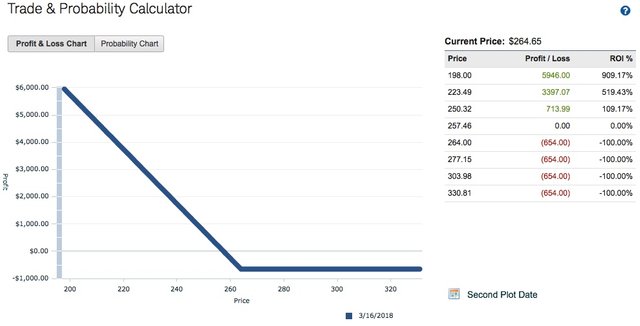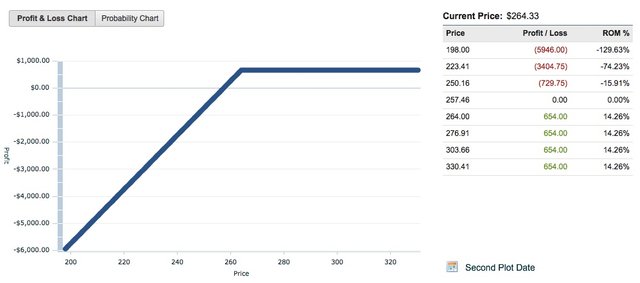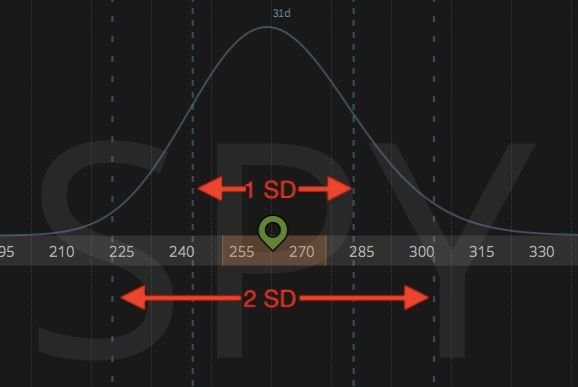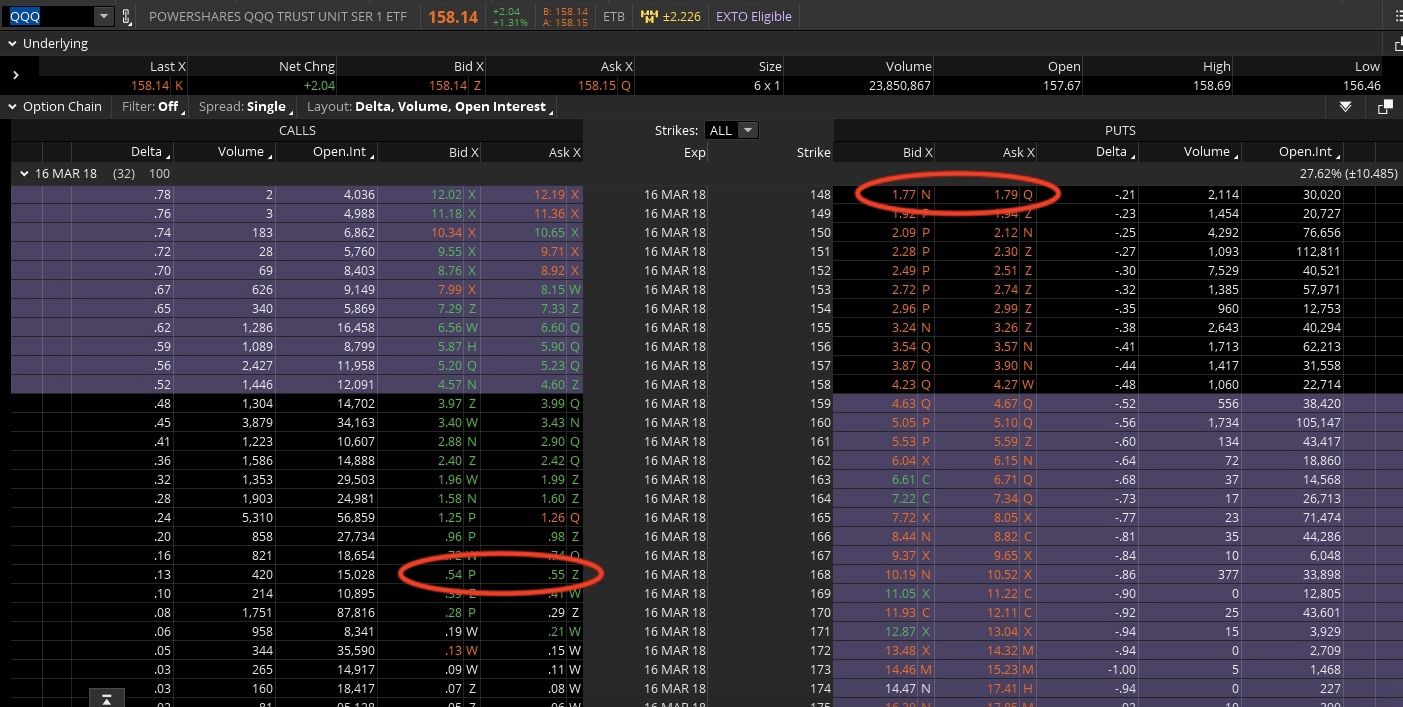Introduction into Options Trading Lesson 2
Hi Steemians,
this is the second lesson in my series about options trading.
In the first lesson we talked about why it is better to trade options instead of stocks, I showed you what options are and I showed you in an example the difference between buying and selling calls.
If you haven’t read my first lesson about options trading, you can do it here:https://steemit.com/money/@stehaller/introduction-into-option-trading-lesson-1
Today I want to show you the difference between buying and selling puts.
At the time of this writing the SPY is trading at 264.50.
So first lets have a look at buying an at the money (atm) put in SPY March expiration.
Buying a put is a bearish strategy. If you buy a put you want the underlying stock to down. The mid price for the SPY March 264 put at the time of this writing was $6.54. Since one option contract represents 100 shares of stock, in order to buy to open this put you have to pay a debit of $654 (plus commission). Let’s have a look at the risk profit and loss graph:

Since you paid a $654 debit for this trade, your break even point at expiration is 257.46.So you need to move SPY pretty much in order to make money. If the price of SPY closes above 257.46 at expiration, you are going to lose money.The max profit at expiration of this trade is $25,746 (if the SPY goes to zero).
The max loss is what you paid ($654). And the probability of making at least 1 cent at expiration is 39% (POP = 39%):

Now let’s have a look at the other side of the trade:
2. Short SPY ATM Put in March Expiration:
Selling a put is a bullish strategy. But since selling a put is done for a credit, you even make money if the price of SPY stays the same or doesn’t go down beyond your break even point at expiration.
So you sell to open one contract of the SPY March 264 put and get paid $645 (minus commission). A short put comes with a margin requirement, wich at the time of this writing is about $5,128 (brokers raised the margin requirements a bit lately, due to high implied volatility). In an IRA you have to come up with the full amount (strike price times 100 minus credit, plus commission = $25,747).
Let’s have a look at the P&L graph:

Since you get paid $654 for this put, the price SPY can go down to 257.46 at expiration, until you start losing money. Your max profit on your trade is the credit you get paid ($654) and your max loss is $25,747 (if the price of SPY closes at zero at expiration). And the probability of making at least 1 cent at expiration is 61% (POP = 61%)

In summary it can be said, that option buyers are like gamblers at a casino. They can only lose, what they are willing to bet, have a low probability of profit, but their gains can be virtually unlimited. But in the long run all gamblers lose.
The seller of option premium is like the casino. The casino can only make, what the gamblers are willing to bet, the casino has a much higher probability of profit than the gambler and in the long run the casino always wins.
So who you wanna be? The casino or the gambler?
The Roll of Implied Volatility and Put Skew
.
1. Implied Volatility (IV)
Implied Volatility (IV) plays an important role in the options pricing model.
IV shows the uncertainty about the market, which is priced into options.
IV represents, as a percentage, the annualized expected one standard deviation range for the underlying stock based on the options prices.
One standard deviation is a term used in statistics.
In random markets 68% of the time, stock prices fall within one standard deviation.
I told you before, trading options is a math game : )
At the moment the IV in SPY is 28%, so the options market is pricing in an 28% up or down move in SPY in the next 365 days (1 standard deviation). So the price of SPY might either rally to 336, or sell off to 189 during the next 365 days.
The following picture shows you a standard deviation curve for SPY in the next 31 days.
In theory the price of SPY should trade within 1 SD 68% of the time and within 2 SD 95% of the time.

The reality has shown that IV is overstated 83% (thanks to the tastytrade research team for this number) of the time compared to historic volatility.
So the markets don’t move as much, as option markets predict.
That’s reasonable, since the options market is an insurance market. Fear is overpriced, therefore people are willing to overpay for insurance.
That’s another reason, why it is better to sell options premium instead of buying it.
We have seen a huge spike in IV lately and a high IV makes options very expensive.
But IV is mean reverting, meaning it eventually comes down after a huge spike. That’s why selling options in high IV is such a great strategy.
You sell, when options are expensive and buy them back when they are cheap.
2. Put Skew:
Before the 1987 crash options traded without a put skew. Because of the impact of the 25% sell off in one day on October 19th, equity puts trade richer than calls since this day.
Because stocks go up using the escalator, but go down using the elevator.
Let’s look at an example:
The Nasdaq 100 ETF (Ticker Symbol: QQQ) trades at roughly 158 at the moment.
Without a skew the 148 put should trade at the same price as the 168 call.

As you can see in the options chain, the 148 put trades at $1.78 (mid price) and the 168 call only has a price of 55 cents.
So calls trade much cheaper than puts. This is another reason, why you should sell puts, instead of buying long stock.
Again we covered a lot today.
If you like my trading lessons, please upvote and resteem.
If you have any questions, feel free to ask.
In the next lesson we will talk about the Option Greeks and after that I will show you the most important strategies and how to implement them.
Have a great day,
Stephan Haller
If you like to learn a ton more about trading options, go to: www.tastytrade.com This is the best source on the internet about trading and it's free.
Ein eigenes Videoportal nur über trading? Mit Livefernsehen. Das Thema ist wohl größer, als man sich wohl vorstellen mag.
Ja, Tom Sosnoff und Tony Battista sind ehemalige Market Maker/Floor Trader an der CBOE (S&P 100 Pit), haben dann den ersten online Broker ThinkOrSwim gegründet, für $750 Millionen an TD Ameritrade verkauft, dann tastytrade und vor ca. 1.5 Jahren tastyworks gegründet.
You got a 14.81% upvote from @getboost courtesy of @stehaller!
This post has received a 8.15 % upvote from @morwhale thanks to: @stehaller.
This post received a 0.840 SBD (23.02%) upvote from @upvotewhale thanks to @stehaller! For more information, check out my profile!